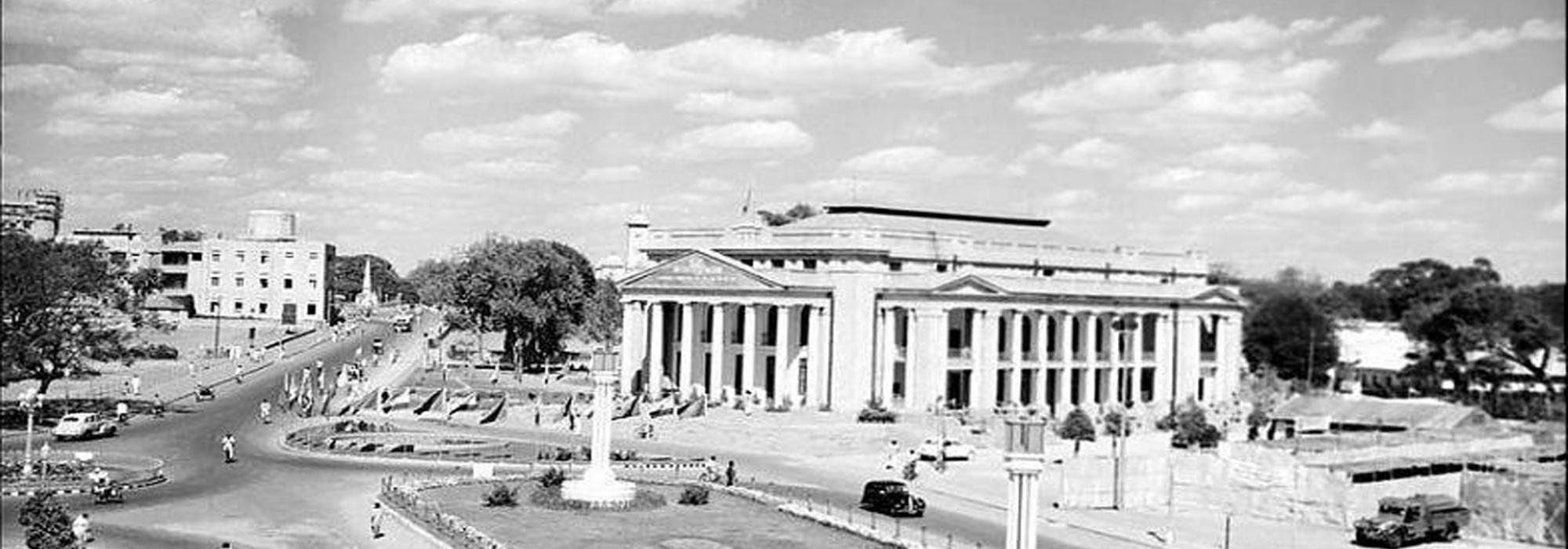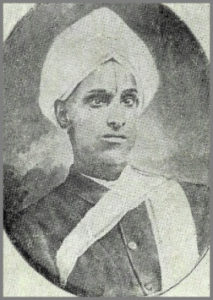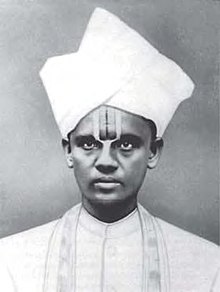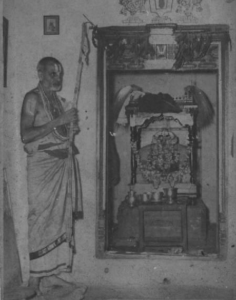Chip off the old block – Bhashyam Ramacharya
Bhashyam Venkatachaarya was the elder of the two grandsons of Bhashyam Tirumalachaarya. He worked as a sub-registrar. Bhashyam Ramacharya was the younger one. He was the person in charge of my peculiar ‘university.’
I became acquainted with Bhashyam Ramacharya sometime during 1909-10. During those days, there was a printing press called the Irish Press in a two-storied building in one corner of a locality called ‘Kottige’ (the place where Chickpet and Akkipet met.) One of the owners of the press was a close friend of Bhashyam Ramacharya. The Irish Press was an object of great fascination for Bhashyam Ramacharya, for he had a taste for printing and publishing in his blood. During that period (in 1909-10), The Mysore Times, a bi-weekly, was being printed at the Irish Press. Since I was the assistant editor of the publication and spent time there, I got the opportunity to get acquainted with Ramacharya.
Right at the start, I was deeply influenced by the sort of respect that Ramacharya got from everyone. He had obtained an M. A. degree from the Allahabad University; he was a well-read scholar of Sanskrit; a sincere traditionalist; pure within and on the outside. On occasion, his words were caustic and astringent. The reason for this was the emotional disgust he experienced due to the immoral behaviour he saw in the world. But the sour taste of his words would immediately float away in his light-hearted humour.
Ramacharya had inherited the rights to a few books published by his ancestors. The primary ones among those books were ಸಂಕ್ಷೇಪ ರಾಮಾಯಣ[1] (Saṅkṣepa Rāmāyaṇa), ಶಿವಾನಂದಲಹರಿ[2] (Śivānandalahari), and ಶುಕಸಪ್ತತಿ ಕಥೆಗಳು[3] (Śukasaptati Kathegaḻu) – these I remember. He was making an attempt to edit those books and publish them in a convenient size.
Ramacharya was employed in the Government Secretariat. Outside his office hours, he spent his time in studying literature, or in performing his daily rituals, or in conversations with his friends.
Typically, every evening, a group of friends gathered at his house. Often I would be a part of it. The main members of the congregation were G. G. Narasimhacharya, his brother R. A. Krishnamacharya (both were abiding disciples of Swami Vivekananda), Pandit Asuri Anandalvar (who would later become the pīṭhādhipati—spiritual head—of the Yadugiri Yatirāja Maṭha), S. G. Narasimhacharya’s son Rangaswamy, Dharmapravartaka Navinam Ramanujacharya who was the dharmādhikāri of the Palace, Forest Conservator H. Srinivasa Rao, occasionally Advocate C. Sheshacharya, and some others. They discussed topics in philosophy and literature as well as world affairs. I will share with you what I know about some of them.
G. Narasimhacharya (GG)
I have mentioned about G. G. Narasimhacharya earlier. He had the good fortune of learning about the greatness of
Swami Vivekananda from direct experience. There was one Alasinga Perumal who had gained the affection and respect of Swami Vivekananda. He was a lecturer in Pachaiyappa's College in Madras. He was a scholar, patriot, and a gentle soul[4]. Supported by a few of his friends, inspired by Vivekananda, he ran a monthly magazine in English called Brahmavadin.[5] It was a scholarly magazine, with erudite savants contributing articles. Profound concepts in the Vedas and Upaniṣads were discussed and explained. Alasinga Perumal, who had successfully handled such a remarkable endeavour, was a relative and friend of GG. It was but natural that an interest in the Veda, Vedānta, and resplendent love for the country were patently visible in GG. I have heard that on one occasion, GG’s superior office, a deputy commissioner, spoke lightly of India and Hindus, causing him to flare up in anger; and as a heated discussion followed, GG rolled up his coat sleeves and displayed his readiness for a fist fight. I can believe it, for GG was such a person. Exceedingly gentle in friendship, but like Bhīmasena when he encountered malice and mischief. He wouldn’t speak much, but the proximity of his smiling and pleasant mien would fill us with enthusiasm and assurance.
R. A. Krishnamacharya (RAK)
That R. A. Krishnamacharya had, like his elder brother, passed the B. A. exam, is a small of matter of detail. Among the people I have seen, he is one who can be called a philosopher[6]. His scholarship was multi-faced. A forceful oratory style in English, familiarity with numerous treatises in philosophy and the sciences, a sharp and decisive style of arguing in logic, the sincerity to explain and elucidate matters in his expositions – these were the salient features of RAK’s scholarship.
Articles submitted to the Brahmavadin would be sent to him for editing and polishing. He would carry out the task without any desire for recognition. In a scholarly discussion, he would write, for example, “Vijñānabhikṣu has expounded this. As a reply, Vācaspati says thus. But it appears that Vācaspati has failed to notice one aspect of Vijñānabhikṣu’s argument. We can find a convincing explanation for that in Sureśvarācarya’s Tattva-vārtika, which is thus.” RAK’s strength was in analyzing the arguments and counter-arguments of various philosophers and unravelling the tangled complex. Especially when he stood up to make a speech, the force of his arguments and the heat in his oration would provoke and fire-up one and all.
In his conduct, RAK was childlike. Though endowed with a tall and handsome form, he would dress shabbily with old and faded clothes. He would wear them haphazardly on his body. A person seeing him from afar would think of him as an idler and a bum. He was similarly unconcerned about his food habits. He led a life of casualness and randomness.
He was extremely affectionate towards youngsters. During their examination season, he often cooked tasty dishes, pack them, and himself carry the food to the venue of the exam, feed them by his own hand, offer them coffee and water; and fill them with courage and confidence. This service was not restricted to students from his own household or those of his relatives. As long as the food lasted, it was served to any student who approached him.
I remember him ever so often. Such a brilliant man did not undertake any monumental work of lasting impact and fame – this paucity tinges my memory. But RAK was a vedāntin in the true sense of the word. He neither felt the urge that he had to do something nor had the obstinacy to definitely accomplish anything. Whenever whatever work comes my way, then and there if I execute it well, is that not sufficient? – such was his disposition[7]. It appears that his philosophy was: The flower that has bloomed today is to be used for today’s pūja[8], for today’s enjoyment. Why should I bother about tomorrow? This is an precept that we should learn from him. Have not many lost their name through greed for fame? Should one work only coveting fame?
Asuri Anandalvar
He was a great man. Asuri was his family name – “Āsūryanantāhvayaḥ.”[9] He was a scholar in the Archaeological department. He was a scholar of the highest order in Sanskrit literature, Alaṅkāraśāstra (Indian Aesthetics), Sanskrit Vyākaraṇa (Grammar), Tarkaśāstra (Indian Logic), and Vedānta. He achieved great success in those fields. He could compose ornate Sanskrit poetry of a high order. He was a witty speaker, rapier-sharp in his arguments, and steadfast in performing ceremonial rituals. He was a favourite of the Sringeri guru Sri Sivabhinava Narasimha Bharati Swamiji. The guru would frequently invite him, discuss with him, and would honour him with gifts.
Asuri Anandalvar was a disciple of Periyaswami Tirumalacharya of the Sadvidyā Pāṭhaśāla in Mysore. A few years after his retirement from the Archaeological department, he was anointed as the guru of the Yatirāja Maṭha of Melkote. Other than in serious debates, he came across as an absolutely benign bhāgavata[10] with an ever-smiling face, love for humour, full of compassion, and wholly independent of any influences.
Circa 1909-10, a statue of Adi Shankaracharya was installed at his birthplace Kalady by the Sringeri Swami and Anandalvar was invited to attend the event. Anandalvar composed a few poems in Sanskrit for the occasion, which was published as a book; he himself presented a copy of that book to me. Just by looking at the main topics in that book, one can clearly see the generosity in his outlook and his large-heartedness. The topics are as follows:
- Sarasvatī maṇihārayaṣṭiḥ (The jewelled necklace of Sarasvatī)
- Śrī Candramauḻīśvara stutiḥ (Praise of the moon-crested Śiva)
- Śrī ratnagarbha Gaṇapatiḥ (Gem-filled Gaṇapati)
- Śrī guruvara nutiḥ (Salutation to the great guru)
- Śrī Śaṅkarācārya mūrtipratiṣṭhābhinandanam (Salutation to the Statue of Shankaracharya)
- Śrī Śṛṅgagiri Śāradāstutiḥ (Praise of Sharada at Sringeri)
- Śrī Saccidānanda Śivābhinava Nṛsiṃha Bhāratī svāminaḥ
- Sphaṭika śilāmūrtiḥ (The crystal statue)
- Śrī Candraśekhara Bhāratī svāminaḥ
The person who wrote these Śaiva-Advaita encomiums was a staunch śrīvaiṣṇava – particularly one who would go on to head the Śrīmadrāmānujīya Maṭha at Melkote![11] Looking at the way he has—wholeheartedly and without reservation—praised Śiva and Śaivism, a deity and sect other than his own, it becomes clear to our minds that our people, once upon a time, exhibited catholicity and magnanimity even while being totally faithful to their own sect. Those who are disturbed by the present-day strife between the Śaivas and the Vaiṣṇavas and the furore caused by Dvaita-Advaita disputes, may find some solace if they call to memory the magnanimity displayed by Anandalvar. As man approaches the Supreme spirit, his small-mindedness and stubbornness break away naturally. In the world of mortals, which man has directly seen the Ultimate? And, is the Supreme not capable of manifesting Itself depending on how one’s eyes perceive It? The visible manifestation of Truth is aligned to the emotion of the seeker, the one intent on realization. The validity of Advaita, or Dvaita, or Viśiṣṭādvaita, is not outside of the worshipper, but inside him – in his way of life, in his experience. Therefore, intolerance towards other sects brings no prestige to Truth! Admitting the possibility that the other sect also has some truth is the veneration that one shows towards Truth. We can learn this from the gesture of Anandalvar, a follower of Rāmānuja, who showed courtesy and respect to the institution of Śaṅkara.
Asuri Anandalvar was a true sport. I already mentioned that he was a favourite of the Sri Sacchidananda Sivabhinava Narasimha Bharati Swamiji, the ‘jagadguru’[12] of the Sringeri Maṭha. I also mentioned that Jagadguru had called Vidvān Anandalvar to Kalady, the birthplace of Ādi Śaṅkara, on the occasion of the installation of the statue of the ācārya. During his visit to Kalady, Anandalvar had written a Sanskrit poem about the dressing style of the women in the Tiruvankur and Kochi regions. The poem has not been published, but was included in a letter he wrote to his friend. Most of that poem remains in my memory. It ran thus –
nirmoko yadi śāradendumahasāmāyasya saṅgṛhyate
divyaistena kuvinda-tantu kuśalairyajjālikā kalpyate।
āseko himavālukāmbupṛṣatastatrāsakṛttanyate
śakyaṃ kerala subhruvāṃ stanataṭaṃ kartuṃ nicolāñcitam॥
The import of this poem is: If the slough of the lustre of the moon in Autumn is separated with difficulty, and that is woven into a net by the skilled weavers in heaven, and if that net is dipped in the fragrant waters in which edible camphor is dissolved, and then made into a cloth, then it may be possible to make the beautiful women of Kerala wear blouses – implying that otherwise they don’t wear blouses.
When he showed this poem to me, I dared to suggest an amendment. In the fourth line of the poem, why not replace the two words ‘nicola’ + ‘añcitam’ = “nicolāñcitam” (nicola means ‘blouse’) in the end by three words ‘na’ + ‘cela’ + ‘añcitam’ = “na celāñcitam” (cela means ‘cloth’). When thus modified, I explained, will it not mean that even if given such clothes, you cannot persuade the beautiful women of Kerala to wear blouses or drape a cloth on their chest? The elderly connoisseur then teased me softly saying, “Attaboy! You sure indicate your preference!”
An incident that was narrated to me by a friend now comes to mind. That friend—Lingana Somayaji—hails from Andhra and is a lawyer by profession; he is a good Sanskrit scholar too. He is an expert in Advaita Vedānta literature; he has written highly respected Sanskrit commentaries on a number of famous books and has also composed many easy-to-read glosses in Telugu on the Upaniṣads. Though he owed allegiance to the creed of Śaṅkara, he had immense reverence towards Anandalvar Swami (we habitually addressed Anandalvar as ‘Anandalvar Swami,’ even before he took up saṃnyāsa.)
Anandalvar Swami had always been exceedingly interested in literature and poetry. He had perused and polished many texts of Indian Aesthetics. Even after he embraced saṃnyāsa, in the Yatirāja Maṭha, he had edited and published a few poetical works and treatises on poetics.
The aforementioned Lingana Somayaji was once with Anandalvar Swami and the conversation turned to the topic of Swami’s publication of books on poetry. My friend asked the Swami in Sanskrit, “Is it right for a renunciate to have interest in poetry? Is it not ordained— kāvyālāpāṃśca varjayet— that one should eschew such interests? How can an ascetic have a desire for rasa (enjoyment)?”
In reponse, the Swami did not say anything of his own, but quoted a sentence from the Upaniṣad –
raso vai saḥ। rasagṃ hyevāyaṃ
labdhvā ānandī bhavati॥
(The form of īśvara is rasa. Hence, Bliss is only through experiencing rasa.)
Somayaji was satisfied. He got up and offered his respect by doing three pradakṣiṇas[13] and falling at his feet, begging for pardon. The Swami honoured him with a smile.
Such was the illustrious Anandalvar. Exceedingly simple while dealing with fellow beings; in life, a great connoisseur filled with empathy; prescient in his vision of the Truth; and spotlessly pure in conduct.
A mischievous joke
Among the scholars who would haunt the Bhāṣyam Devaḍi was Navinam Ramanujacharya. He was a great scholar. He had toured North India – the Baroda and Jaipur regions – many a time. He was intimately familiar with North Indian languages like Hindi, Marathi, Bengali, and Gujarati. On one occasion, he quoted this poem:
anuditayavaṣasakārairyeṣāṃ bhāṣā samullasati।
gudavadana vivara bhedaḥ kevalamanumīyate dantaiḥ॥
“When one hears words from people whose sentence does not have the letters ya, va, ṣa, and sa (i.e. ya-kāra, va-kāra, ṣa-kāra, and sa-kāra), one can only guess from which orifice of the body the sound originated only by looking at their teeth!”
Ramacharya
It was the house of Bhashyam Ramacharya where such stalwarts would come together. No divine or earthly topic exists that didn’t come up for discussion there. Stimulating knowledge, enquiring nature, and independent thinking were amply evident in all matters of discussion.
Even though Ramacharya was a Sanskrit scholar and tradition-bound, he was not unfamiliar with western education and the sciences. I once resolved to write an article in Kannada summarizing the work On Liberty by the famous philosopher John Stuart Mill and told Ramacharya about it. He then handed me from his stack of old papers the notes that he had prepared. There were, in those notes, summarized reviews about Mill and another philosopher called Herbert Spencer. Having seen that, I got an idea of the width of his knowledge.
Since then, I have seen, and continue to see, many great personalities, but I wonder why such quest for knowledge and such zeal for inquiry are seldom seen. Or maybe such people do exist, but the fortune of meeting them has not come my way!
Concluded.
This is the second part of an English translation of the twelfth chapter of D V Gundappa’s Jnapakachitrashaale – Vol. 1 – Sahiti Sajjana Sarvajanikaru. DVG wrote this series in the early 1950s. Edited by Hari Ravikumar.
Footnotes
[1] An abridged Rāmāyaṇa.
[2] A composition of Adi Shankara.
[3] Seventy tales narrated by a parrot.
[4] The original has ‘ಸಾತ್ತ್ವಿಕ’ (sāttvika), which is the nature of sattva (benign goodness).
[5] This later became Vedanta Kesari.
[6] DVG uses the word ತತ್ತ್ವಜೀವಿ (tattvajīvi) suggesting that RAK’s philosophy and his life were closely aligned; he lived his philosophy.
[7] The original has ಮನೋಧರ್ಮ (manodharma), which means ‘state of mind,’ ‘temperament,’ etc.
[8] Worship; typically fresh flowers are used for daily worship.
[9] This Sanskrit phrase translates to ‘Āsūrī Ananta,’ the family name.
[10] In this context, the word refers to a respected scholar and elder; in specific, the word is used to signify a scholar-orator-singer who gave lectures on topics related to the Itihāsa-Purāṇa literature peppered with songs, typically bhajans.
[11] He ascended the pīṭham of the Yadugiri Yatirāja Maṭha in 1921.
[12] Literally, ‘guru of the world.’
[13] Going around (someone or something) in a clockwise manner); circumambulating.















































